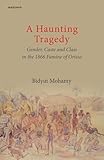A haunting tragedy : gender, caste and class in the 1866 famine of Orissa / Bidyut Mohanty.
Publisher: New Delhi : Manohar Publishers & Distributors, 2022Description: 421 pages : maps (black and white) ; 23 cmContent type:- text
- 9789390729630
- 305.42054
- HC437.O7 M575 2022
| Item type | Current library | Shelving location | Call number | Status | Notes | Date due | Barcode |
|---|---|---|---|---|---|---|---|
 BOOKs
BOOKs
|
National Law School | New Arrival - Display Area | 305.42054 MOH (Browse shelf(Opens below)) | Not for loan | Recommended by Dr. Kena Wani | 39578 |
Includes bibliographical references and index.
1. Introduction;
2. The Political Economy of Orissa, 1860-1921;
3. The Great Orissa Famine of 1866: The Event and the Process;
4. Relief and Caste: Emergence of the Chhatrakhia Community;
5. Later Famines: Social Impact and State Response;
6. Female Mortality in Famines, 1866-1974;
7. Gender and Class Incidence of Infectious Diseases;
8. Gender Discrimination in Food and Health Care;
9. Rise and Fall of Sex Ratio;
10. Migration in the Famine Era: Gender, Caste and Class;
11. Famine and Women, Past and Present: Some Concluding Reflections;
Glossary;
Index.
This book is a detailed analysis of the food scarcity and epidemics among the womenfolk and other vulnerable sections of society in colonial Orissa. Its major significance lies in the fact that the food crisis, mass exodus and adverse sex ratio continue to raise questions in the contemporary world. Studies of such experiences help in re-designing strategies to meet the challenges arising from natural disasters, wars, pandemics, besides poverty and uncertain production outcomes. The study of Orissa Famine of 1866 explodes the myth upheld by the colonial administrators that women died at a lower rate than men in famines, because they could easily adapt to food scarcity and were supposedly less prone to infectious diseases. Evidence based on historical, sociological and biological factors showed that increasing male migration, much of it, leading to high mortality, explains the change in sex ratio during the colonial period. This work also shows that many of today's consumption preferences, linguistic usages and cultural habits of people, carry traces of cataclysmic experiences. This book also highlights the fact that most famines are the result of policy failures and, are often rooted in structural inequalities with serious consequences for women, lower castes and the poor alike. About the Author of several books, Bidyut Mohanty is the Head of the Women’s Studies Programme at the Institute of Social Sciences, New Delhi. She has engaged in several projects concerning women's development, local self-government and agrarian history.

There are no comments on this title.